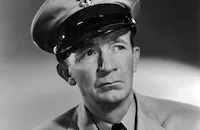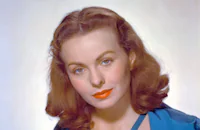Home in Indiana

Brief Synopsis
Cast & Crew
Henry Hathaway
Walter Brennan
Charlotte Greenwood
Ward Bond
Charles Dingle
Lon Mccallister
Film Details
Technical Specs

Synopsis
When teenaged orphan Sparke Thornton is sent to live with his uncle, J. T. "Thunder" Bolt, and aunt, Penelope, in Indiana, the sullen youngster decides to run away on the first day of his arrival. As Sparke is walking, however, he comes across a harness racing track on the neighboring farm, owned by Godaw Boole, and watches as Charlotte "Char" Bruce works a horse. Sparke admires Char's driving ability and talks with black handler Tuppy, who reveals that Thunder's Roundhouse Farm was once a prestigious training ground for harness horses, and that Thunder was a well-respected sulky driver. Thunder's remaining horse, The Lady, is still a beautiful, loving animal despite her blindness and Thunder's neglect of her, and Sparke decides to stay at Roundhouse after Tuppy promises to teach him how to drive a sulky. When he returns to the Roundhouse for supper, Sparke tells Thunder and Penny about his great love for horses, but Thunder orders him to attend school instead of hanging around Boole's property. The next day, Sparke promptly goes to Boole's ranch and, as he is walking across a field, is charged by Hamilcar Chief, a high-spirited stallion. Sparke calms the animal, however, and his instinctive rapport with Chief impresses Boole's daughter Christopher, who is called "Cri-Cri." Cri-Cri persuades head trainer Jed Bruce to give Sparke a try at driving, and although Sparke fails the test, his humility and willingness to learn convince Bruce to allow him to return. Sparke works diligently with Char and Tuppy and soon develops the "hands" of gentleness and strength needed to guide a harness horse. One evening, Thunder is drunk when Sparke returns home, and Aunt Penny explains that Thunder, who used to be partners with Boole, was ruined by him after they quarreled over Boole's harsh treatment of a mare. Racing is still in Thunder's blood, however, and his hostility and drunkenness result from his long-stifled desire to return to the track. Sparke is determined to help his uncle, and later that night, sneaks Chief out of his stable to visit Lady. The next morning, Char and Moe Rum, Chief's groom, see Sparke returning Chief, and Sparke talks them into helping him obtain the certificate required to prove that Chief is the father of Lady's foal. Later, the trio succeed in obtaining the documents, and Lady's foal, Maudeen Four, is born. Thunder, who was at first furious with Sparke for his meddling, is delighted by Lady's daughter and helps Sparke train her. Sparke's obsession with horses is occasionally interrupted by his infatuation with the sophisticated Cri-Cri, who considers him too young to be taken seriously. Char is in love with Sparke, but he is unaware of her feelings and thinks of her as his best friend. On the day of Sparke and Maudeen's first race, they win the first heat, but are "boxed in" by a rival driver during the next heat and Maudeen is injured. Sparke trounces the other driver in a fistfight, and then anxiously tends to Maudeen. Later, the horse has fully recovered, and Sparke prepares for their next race. Before the event, Sparke realizes how Char feels about him and that he returns her affections. Meanwhile, Tuppy and Thunder have discovered that Maudeen is going blind, like Lady, but decide to let Sparke race her. With skill and determination, the pair win the race, although Sparke is devastated at the end when he realizes that Maudeen is now completely blind. Thunder, whose zest for work has been restored, reassures Sparke that Maudeen will still have a happy life, and that her offspring will be trained to become great champions. Bruce, who has quit as Boole's trainer, decides to join the Roundhouse and help restore its glory, and Sparke and Char kiss as they ride home with Maudeen.

Director

Henry Hathaway
Cast

Walter Brennan

Charlotte Greenwood

Ward Bond

Charles Dingle
Lon Mccallister

Jeanne Crain

June Haver
Robert Condon

Willie Best
George H. Reed
Charles Saggau
Noble "kid" Chissell
Arthur Aylsworth
Sam Hayes
Roger Imhof
Francis Ford
Sam Mcdaniel
Tom Dugan
Eddy Waller
Carl "block" Hoffman
Joseph A. Neville
Miss Sarah Abbey
C. M. Saunders
Jake Mahoney
James Farley
Harry Strang
Frank Darien
John Elliott
Joe Bernard
Tom Mcguire
Crew
James Basevi
Bonnie Cashin
Edward Cronjager
André Daven
Mack Elliott
W. D. Flick
Hugo W. Friedhofer
Chester Gore
Robert E. Goux
Burris Grimwood
James F. Hanley
H. D. Happ
Roger Heman
R. L. Hough
Frank E. Hughes
Harmon Jones
Natalie Kalmus
Thomas Little
Paul E. Macpherson
Winston Miller
Richard Mueller
Emil Newman
Guy Pearce
Gene Rose
Geneva Sawyer
Fred Sersen
Erich Von Stroheim Jr.
Henry Weinberger

Film Details
Technical Specs

Award Nominations
Best Cinematography
Quotes
Trivia
Notes
George Agnew Chamberlain's novel first appeared as a serial in The Saturday Evening Post (18 October-8 November 1941). Hollywood Reporter news items indicate that as early as November 1940, Twentieth Century-Fox announced interest in making a film about trotting races, to be entitled Home in Indiana. The proposed picture, which was to be a follow-up to the studio's successful horseracing films Kentucky and Maryland, was to star John Payne, Walter Brennan and Fay Bainter, be produced by Kenneth Macgowan and feature a script by John Taintor Foote. Although Foote did work on the screenplay for the proposed Macgowan picture, it does not appear likely that his work was included in the final version of Home in Indiana. According to a March 12, 1942 Hollywood Reporter news item, agent Charles K. Feldman was "collecting the ingredients" for a "package deal" for Chamberlain's novel, to be produced by Howard Hawks. Winston Miller wrote a screenplay for Feldman based on Chamberlain's book, and according to the Twentieth Century-Fox Records of the Legal Department, located at the UCLA Arts-Special Collections Library, Miller's script was purchased by the studio along with the rights to the novel. The legal records indicate that Philip Lewis worked on a version of the film's screenplay, but the extent of his contribution to the completed film has not been determined.
The legal files also note that Clem Bevans was signed for a part in the picture, but he does not appear in the finished film. According to Hollywood Reporter news items, George Cleveland had been offered a role in Home in Indiana but turned it down to appear in another film, and Hermes Pan was originally signed to direct the jitterbug dance sequence, for which Geneva Sawyer receives onscreen credit. Actor Lon McCallister was borrowed from Sol Lesser's company for the production. As noted in the onscreen credits, Home in Indiana marked the first leading roles for Jeanne Crain and June Haver; McCallister, however, who is also billed as a "young player," had previously appeared in a featured role in Stage Door Canteen (see below). The following location sites for filming were noted by contemporary news items, studio publicity and legal records: sulky races at Empire City, NY; the Sandusky County Fair in Fremont, OH; the Marion County Fair in Marion, OH; Castleton Farms and Walnut Hall in Lexington, KY; MacGowan Farm in Mt. Sterling, KY; and Reuss Ranch in Malibu, CA. Hollywood Reporter news items note that the picture had numerous showings from June 14, 1944 through June 28, 1944 at a variety of locations in Indiana, Kentucky and Ohio, several of which were attended by Crain and Haver. Cinematographer Edward Cronjager received an Academy Award nomination for his work on the picture.
On October 2, 1944, Lux Radio Theatre broadcast a version of the story starring Walter Brennan, Charlotte Greenwood and Edward Ryan. In 1957, Twentieth Century-Fox released April Love, a musical version of Chamberlain's novel, which starred Pat Boone and Shirley Jones and was directed by Henry Levin.













